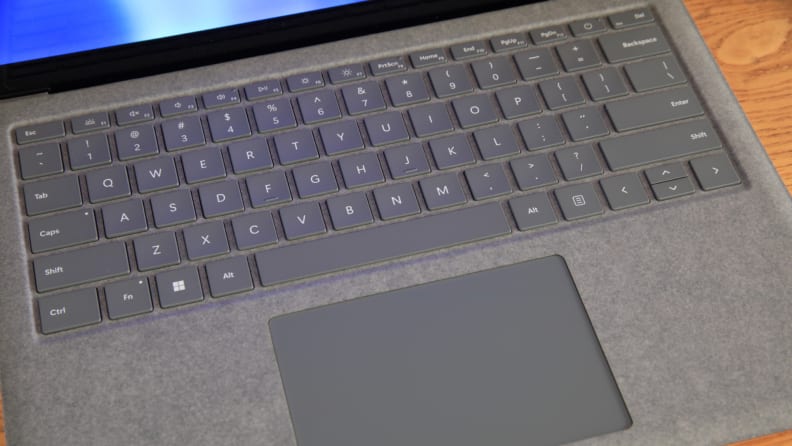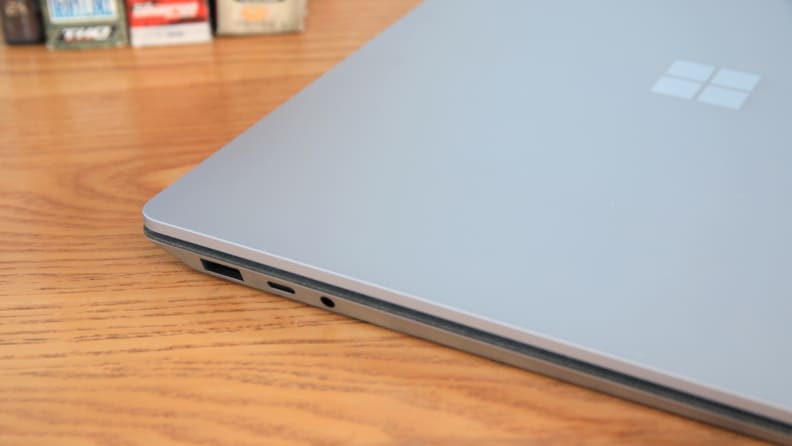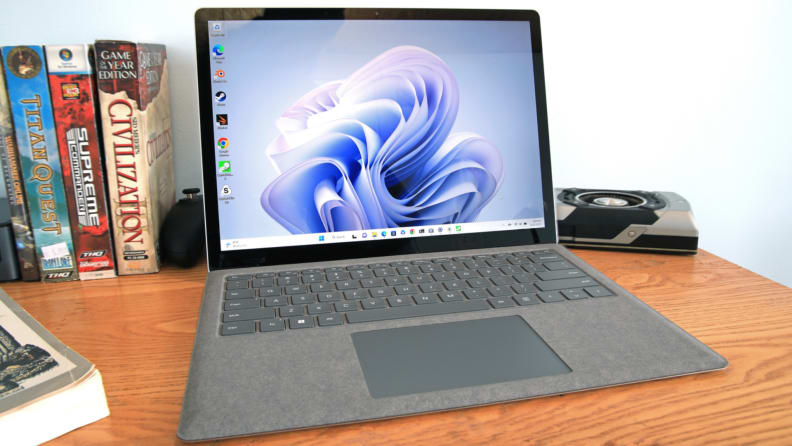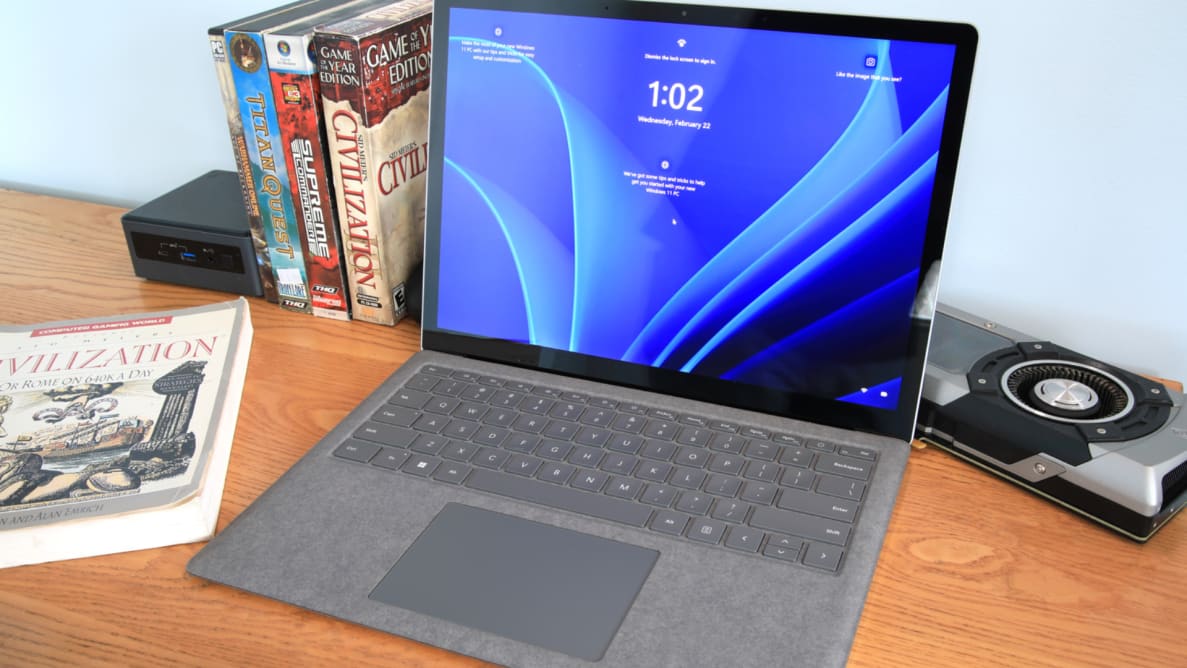Pros
-
Design still looks modern
-
Great keyboard and responsive touchpad
-
Good battery life
Cons
-
Disappointing performance for the price
-
Limited port selection
-
720p webcam
About the Microsoft Surface Laptop 5:
Here are the specs of the laptop we tested:
- Processor: Intel Core i5-1235U
- Graphics: Intel Iris Xe
- RAM: 8GB
- Storage: 512GB NVMe SSD
- Display: 13.5-inch IPS LCD (2256 x 1504 resolution) 60Hz refresh rate
- Wireless connectivity: Wi-Fi 6, Bluetooth 5.1
- Wired connectivity: 1x Thunderbolt 4 / USB-C, 1x USB-A 3.1, 1x 3.5mm headphone jack, 1x Surface Connect
- Weight: 2.8 pounds
- Size: 12.1 x 8.8 x 0.57 inches
- Warranty: One-year manufacturer warranty
This configuration is the step-up from the base model, which retails at an MSRP of $1,000. Paying another $300 nets you a 512GB solid state drive instead of the base model’s 256GB drive, but the two are otherwise identical.
The Surface Laptop 5’s 13.5-inch model’s most performant configuration is also rather tame, maxing out with an Intel Core i7-1255U processor, 16GB of RAM, and a 512GB solid state drive for $1,700. There’s also a 15-inch display configuration that supports up to 32GB LPDDR5x of RAM and up to 1TB of storage, but the only processor option is the Core i7-1255U. The most expensive Surface Laptop 5 configuration costs $2,400 before subscriptions or accessories.
The 13.5-inch version comes in the following colors: platinum, sage, black, and sandstone. The 15-inch version comes in platinum or black only.
What we like
It looks fantastic

The Microsoft Laptop 5 can be described as both modern and minimalistic.
The Surface Laptop 5's minimalist look is a testament to Microsoft's design prowess. The laptop's clean, sharp lines and smooth matte metal finish give it a luxurious yet professional look that punches over its mid-range price point. The optional Alcantara fabric interior (only available with the 13.5-inch model) is a unique design decision that adds a touch of warmth and comfort to the device. While some might worry about its durability, I’ve used an original Surface Laptop (yes, the 2017 model) for years without significant wear to the fabric.
Microsoft offers several unusual color options for a modern laptop, as I described above, and they help the Surface Laptop 5 stand out on the shelf compared to the muted palettes from other brands. However, I’m disappointed Microsoft only offers the Alcantara fabric with the platinum color (and on the smaller laptop, no less), since it offered additional Alcantara color options on prior models as recent as the Surface Laptop 4.
Unlike most laptops, which have a 16:9 or 16:10 display aspect ratio, the Surface Laptop 5’s 13.5-inch display has a 3:2 aspect ratio. It’s much closer to square than a typical laptop display, which makes the laptop’s footprint more square, too. This is a downside if you’re looking for a more portable 13-inch machine, as the Surface Laptop 5 is much larger than the Dell XPS 13, and a bit larger than the MacBook Air 13 M2. But the 3:2 aspect ratio gives the laptop a more spacious interior with plenty of space to rest your palms.
Build quality is excellent, as well. The laptop’s lower half hardly flexes when handled roughly, and the same is true of the display lid. Apple’s MacBook Air M2 remains the king of quality with its slate-like feel, but the Surface Laptop 5 is a close contender. Microsoft has an edge over the Dell XPS 13 and Asus Zenbook S 13 OLED, both of which also feel sturdy, but can’t quite match the Surface Laptop 5.
The 13.5-inch display is larger than it seems
As mentioned, the Surface Laptop 5 boasts a 13.5-inch display with a 3:2 aspect ratio and a resolution of 2256 x 1504. This translates to a pixel density of 201 pixels per inch. Although it falls short of Apple's Retina displays, which aim for a higher 220 pixels per inch, it’s a tad sharper than a similarly sized 1920 x 1200 display, like that found in the Dell XPS 13.
Color performance is held back by the standard IPS panel and the lack of special features like HDR or Apple's True Tone. It’s comparable to some mid-range alternatives, such as the Dell XPS 13, but many new laptops from Asus, Acer, and Samsung now offer OLED displays that make the Surface Laptop 5’s IPS screen look obsolete. The gap is most noticeable when streaming high-quality movies and TV shows, or when playing games; both can seem dull and flat on the Surface Laptop 5.
I measured a maximum brightness of 412 nits, which is similar to competing laptops. The Dell XPS 13 can achieve 502 nits, the HP Spectre 14x 360 hits 370 nits, and the Acer Swift 3 OLED reaches 421 nits. The Surface Laptop 5’s mirror-like screen does nothing to reduce reflections, though, so a nearby sunlit window will cause distracting glare.
The Surface Laptop 5’s display supports touch and the Microsoft Surface Pen, which isn’t included. The Surface Pen isn’t useful when paired with the Surface Laptop 5 because, unlike the Surface Pro, it can’t be used as a tablet. Still, it's nice to have the option.
The keyboard and touchpad stand out

Although there haven't been many improvements to the keyboard since released, it's still functional and incredibly responsive.
As far as I know, Microsoft hasn’t tweaked or improved the Surface Laptop 5’s keyboard once in the six years since the original model was released. And you know what? It’s fine. Better than fine, actually. The keyboard is taut, responsive, and offers good key travel with a refined bottoming action. There is some flex in the keyboard, especially in the center, but it doesn’t ruin its overall feel.
The keyboard is backlit and has four brightness settings (including off). The keys are well-lit, but not so bright as to become distracting, and the backlight isn’t visible in a brightly lit room. Apple’s keyboard backlight remains superior, as it offers a wider range of brightness settings, but the Surface Laptop 5 is in line with other mid-range Windows laptops.
The touchpad is great, as well. It's a bit small, measuring about 4.25 inches wide and 3 inches deep, but offers a smooth and responsive surface that (at least on the Alcantara model) stands out nicely from the surrounding material. Windows’ multitouch gestures are easy to use and seem to work more reliably than most Windows laptops.
I also like the touchpad’s clicky left and right mouse buttons, which are built into the touchpad’s surface. There are no haptics here—just good, old-fashioned physical movement. The buttons register with a definitive, reassuring click.
Respectable battery life
Microsoft packs a modest 47.4-watt-hour battery into the Surface Laptop 5. This is a tad smaller than the Dell XPS 13’s 51-watt-hour battery and quite a bit smaller than the HP Spectre x360 14’s 66-watt-hour battery.
The Surface Laptop 5 managed to last 12 hours and 45 minutes in our battery life benchmark, which simulates a web browsing workload. That’s less than the Dell XPS 13, which endured an outstanding 16 hours and 13 minutes, but more than the HP Spectre x360’s result of 8 hours and 15 minutes. The Laptop 5 also outlasts the Asus ZenBook S 13 OLED and Lenovo Yoga 6, among others.
Apple’s laptops remain the king of battery life: the new MacBook Pro 14 M2 Pro lasts an outrageously long 24 hours and 12 minutes. In the realm of Windows laptops, though, the Surface Laptop 5 is an excellent choice if long battery life is a mandatory feature.
The Surface Laptop 5 has two charging options: the Surface Connector or the Thunderbolt 4 / USB-C port. Either will do the job, but the bundled power brick charges over the Surface Connector. Frequent travelers may want to ditch the default power brick for a USB-C charger since USB-C can charge a wider variety of devices.
What we don’t like
Performance falls short

The Microsoft Surface Laptop 5 comes in two different sizes—a 13.5-inch and 15-inch display.
The Surface Laptop 5 configuration I tested was a step up from the base model, but only in terms of storage space. It arrived with an Intel Core i5-1235U processor, 8GB of RAM, and a 512GB solid state drive, all priced at $1,300. That’s not impressive hardware; unsurprisingly, it drags down the laptop’s performance.
Geekbench 5, a processor benchmark, produced a single-core result of 1080 and a multicore result of 5320. This trades blows with the Dell XPS 13 powered by Intel’s Core i5-1230U, which scored 1240 in single-core and 4646 in multi-core. However, the Surface Laptop 5 falls behind the MacBook Pro 13 M2, which scored 1895 in single-core and 8983 in multicore, and the Asus Zenbook S 13 OLED, which achieved 1376 in single-core and 6841 in multicore.
Cinebench R23 thrashed the Surface Laptop 5 in its multicore benchmark. With a score of just 4196, this laptop fell way behind the Asus Zenbook S 13 OLED (8747), and the Apple MacBook Pro 13 M2(8696). It’s a similar story in Blender’s CPU benchmark; the Surface Laptop 5 outperforms the base Dell XPS 13 but trails its other competitors.
The laptop’s Intel Iris Xe integrated graphics struggled to run the latest games, as usual. The Surface Laptop 5 turned in a 3DMark Night Raid score of 15265, which is typical for a laptop with Intel Iris Xe graphics but far behind laptops with discrete graphics. Even titles from the PlayStation 4 / Xbox One console generation will often falter below 60 fps at Low to Medium detail settings. Games from the current console generation are unlikely to run at an acceptable framerate without significant cuts to resolution and detail.
None of this means the Surface Laptop 5 feels slow in day-to-day use. On the contrary, it’s often snappy and quick, responding immediately to input and opening programs in a flash. The same is true of most modern laptops, however, so it’s hardly unique.
What really sinks the Surface Laptop 5’s performance potential is the price. The model I tested retails for $150 more than the Dell XPS 13 configuration we reviewed (which, by the way, had twice as much RAM) and matches the MacBook Pro 13 M2, which is a much quicker laptop and has better-integrated graphics performance. Put simply, the Surface Laptop 5 doesn’t have a lot of value when comparing its performance to its price.
Not enough ports

The lack of ports on the Microsoft Surface Pro 5 Laptop is made apparent by its need for an adapter when connecting to other sources.
The Surface Laptop 5 lacks an adequate port selection There are only four, and one is the Surface Connect port used to power the laptop. It also has a Thunderbolt 4 / USB-C power (which can power the laptop), a USB-A 3.1 port, and a 3.5mm audio jack.
That remarkably slim selection of physical connectivity makes the laptop more difficult to use. Need to connect a wired mouse and keyboard? You’ll probably need an adapter. Want to connect to a TV? Adapter. Want to connect to an older monitor or a projector? Adapter. Want to connect multiple external hard drives? You’ll need a USB-C hub, dock, or adapter.
Whether this truly matters depends on how you use your laptop. Some people never connect anything, while others (like myself) end up with four or five devices dangling off their machine. Those who do use a lot of adapters will need a USB-C hub (or Microsoft’s proprietary dock, which uses Surface Connect).
Wireless connectivity isn’t great, either. The laptop doesn’t support the latest Wi-Fi 6E standard, instead of sticking to Wi-Fi 6. Bluetooth, meanwhile, is stuck on Bluetooth 5.1. Neither is likely to be an immediate problem, as most people don’t have devices that use Wi-Fi 6E or Bluetooth 5.3, but this could be a frustration as the laptop ages and devices with these new wireless standards become more common.
Microsoft skimps on the webcam
Many laptops are moving on to 1080p webcams. Apple and Lenovo are particularly bullish here, sticking 1080p webcams into laptops that span a wide variety of prices. Microsoft, however, stuck a lower resolution, 720p webcam in its Surface Laptop 5. It’s not the worst I’ve seen, but the poor video quality is obvious whenever the camera’s video is displayed full-screen. The image appears soft and grainy, especially when lighting is less than ideal (which, let’s face it, is usually the case).
While the webcam isn’t great, the Surface Laptop 5 does offer an IR camera compatible with Windows Hello face authentication. It's quicker, easier, and more reliable than a fingerprint sensor like Apple’s TouchID, giving Microsoft a much-needed win over the MacBook Air M2 and Pro M2.
Should you buy the Microsoft Surface Laptop 5?

Unfortunately, the price on the Microsoft Surface Laptop 5 is too steep for our liking.
No, it’s too expensive for what you get
The Microsoft Surface Laptop 5 is a good laptop sold at the wrong price. It’s a bit shocking to see Microsoft ask for an MSRP of nearly $1,300 for a 13.5-inch laptop with just 8GB of RAM, a mid-tier Intel processor, and integrated graphics. Both the Apple MacBook Air M2 and MacBook Pro 13 M2, while priced at $1,500, still blow it out of the water when it comes to processing speed, enough to make spending $200 more worth it.
Windows competitors like the Dell XPS 13 also put the Surface Laptop 5 to shame. While the XPS 13 we reviewed was a bit slower than the Laptop 5, it was also less expensive. A similarly priced configuration will have a much more capable Intel Core i7 processor, 32GB of RAM, and a 1TB solid state drive—a more potent combo that still retails for $50 less than the Surface. Microsoft frequently discounts the Surface Laptop 5, which can make it more competitive, but it still tends to underperform on value.
It’s a shame because I genuinely like the Surface Laptop 5. It’s an attractive laptop with a good keyboard, responsive touchpad, and decent battery life. As mentioned, I’ve personally used a Surface Laptop for years. When compared to modern peers, though, its modest performance and limited feature set are dealbreakers.
Meet the tester
Matthew S. Smith is a veteran tech journalist and general-purpose PC hardware nerd. Formerly the Lead Editor of Reviews at Digital Trends, he has over a decade of experience covering PC hardware. Matt often flies the virtual skies in Microsoft Flight Simulator and is on a quest to grow the perfect heirloom tomato.
Checking our work.
Our team is here to help you buy the best stuff and love what you own. Our writers, editors, and experts obsess over the products we cover to make sure you're confident and satisfied. Have a different opinion about something we recommend? Email us and we'll compare notes.
Shoot us an email



